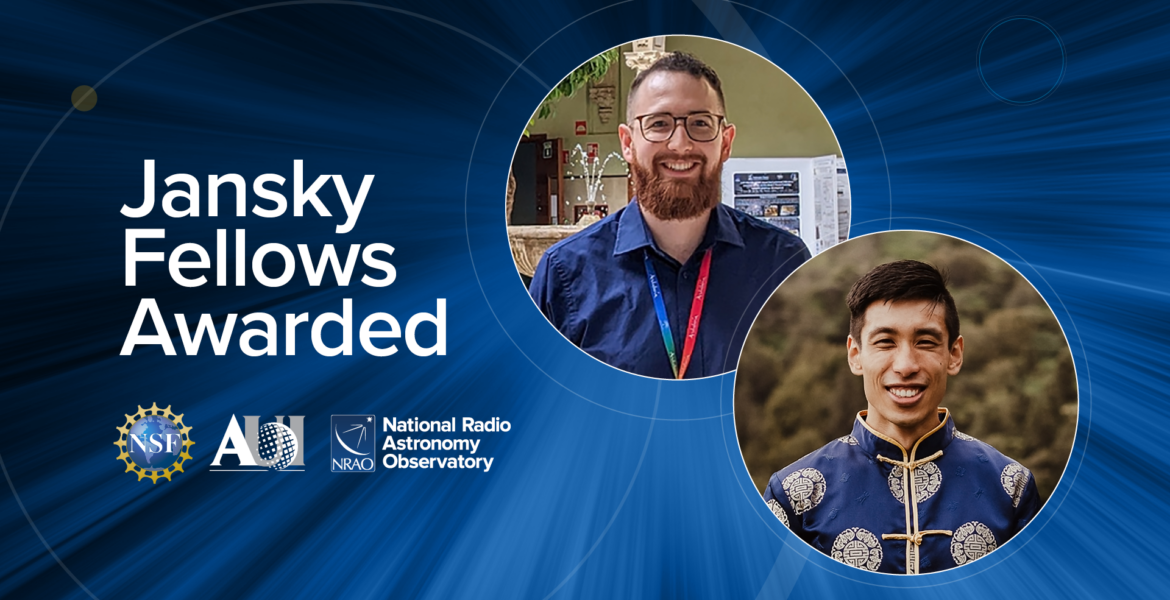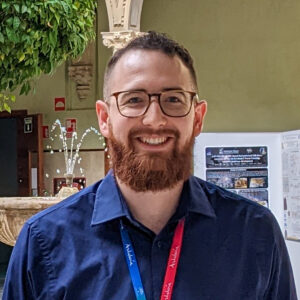AUI will present at the 247th meeting of the American Astronomical Society in Phoenix from January 4-8.
Recent News
ALMA Helps Unmask Monster Black Hole Behind Record-Breaking Cosmic Burst
Astronomers have used the Atacama Large Millimeter/submillimeter Array (ALMA) together with a suite of space- and ground-based telescopes, to study AT 2024wpp, the most luminous fast blue optical transient (LFBOT) ever observed.
Astronomers Make First Radio Detection of Rare Supernova Type, Revealing Secrets of Stellar Death
Astronomers using the U.S. National Science Foundation Very Large Array have captured the first-ever radio signals from a rare class of stellar explosion known as a Type Ibn supernova.
2024 Jansky Fellows Awarded

Credit: NRAO/AUI/NSF
As a part of its central mission to nurture and inspire the next generation of radio astronomers, the National Science Foundation’s National Radio Astronomy Observatory (NRAO) has selected two outstanding early career professionals for its 2024 Jansky Fellowship.
The Jansky Fellowship encourages early career astronomy and engineering professionals to pursue their personal research interests through the lens of radio astronomy, and with the support of NRAO’s observatories and research and engineering resources. Appointed for two years, with the opportunity to renew for a third year, Jansky Fellows develop broad skill sets and establish themselves as innovative, independent research scientists and engineers, and top leaders in the field by deepening their understanding of radio astronomy while collaborating with NRAO scientific staff and their colleagues in the global astrophysics community.
Adam Dong
 Adam Dong earned a bachelor’s degree in engineering in 2015 and a bachelor of science degree in physics in 2017, both from the University of Auckland. He is currently a Ph.D. candidate in astronomy at the University of British Columbia. Adam’s expertise is in characterizing pulsars and Fast Radio Bursts. Using the immense field of view and the large collection area of the Canadian Hydrogen Mapping Experiment (CHIME) telescope, he has led the effort to conduct the largest survey of single pulses from pulsars to date. Adam is also interested in the effects of satellite constellations on current and future-generation radio telescopes. As a Jansky Fellow at Green Bank Observatory in Green Bank, West Virginia, Adam will integrate data from CHIME, the CHIME outriggers, the Green Bank Telescope, and other observatories to explore the new landscape of large fields of view in conjunction with high astrometric precision.
Adam Dong earned a bachelor’s degree in engineering in 2015 and a bachelor of science degree in physics in 2017, both from the University of Auckland. He is currently a Ph.D. candidate in astronomy at the University of British Columbia. Adam’s expertise is in characterizing pulsars and Fast Radio Bursts. Using the immense field of view and the large collection area of the Canadian Hydrogen Mapping Experiment (CHIME) telescope, he has led the effort to conduct the largest survey of single pulses from pulsars to date. Adam is also interested in the effects of satellite constellations on current and future-generation radio telescopes. As a Jansky Fellow at Green Bank Observatory in Green Bank, West Virginia, Adam will integrate data from CHIME, the CHIME outriggers, the Green Bank Telescope, and other observatories to explore the new landscape of large fields of view in conjunction with high astrometric precision.
Kyle Massingill
 Kyle Massingill earned his undergraduate degree in physics at the University of Arizona, where he worked on the Event Horizon Telescope (EHT). He is currently a Ph.D. candidate in astrophysics at Arizona State University, where he has focused on millimeter-wave filter-bank design, simulation, and testing. Kyle has integrated his filter-banks into novel weather sensors that are being tested on high-altitude balloons. Kyle has also worked on multiple extragalactic astronomy analysis projects, focusing on using ALMA data to survey high redshift galaxies. He is currently researching quasars to explore how feedback could be regulating galaxy evolution. As a Jansky fellow, at NRAO in Socorro, New Mexico, Kyle will use his interdisciplinary experience to contribute to calibration strategies for ngVLA and further his scientific research into quasars.
Kyle Massingill earned his undergraduate degree in physics at the University of Arizona, where he worked on the Event Horizon Telescope (EHT). He is currently a Ph.D. candidate in astrophysics at Arizona State University, where he has focused on millimeter-wave filter-bank design, simulation, and testing. Kyle has integrated his filter-banks into novel weather sensors that are being tested on high-altitude balloons. Kyle has also worked on multiple extragalactic astronomy analysis projects, focusing on using ALMA data to survey high redshift galaxies. He is currently researching quasars to explore how feedback could be regulating galaxy evolution. As a Jansky fellow, at NRAO in Socorro, New Mexico, Kyle will use his interdisciplinary experience to contribute to calibration strategies for ngVLA and further his scientific research into quasars.
The National Radio Astronomy Observatory (NRAO) is a facility of the National Science Foundation, operated under a cooperative agreement by Associated Universities, Inc.
This news article was originally published on the NRAO website on April 30, 2024.
Recent News
AUI to Attend AAS 247 Conference
AUI will present at the 247th meeting of the American Astronomical Society in Phoenix from January 4-8.
ALMA Helps Unmask Monster Black Hole Behind Record-Breaking Cosmic Burst
Astronomers have used the Atacama Large Millimeter/submillimeter Array (ALMA) together with a suite of space- and ground-based telescopes, to study AT 2024wpp, the most luminous fast blue optical transient (LFBOT) ever observed.
Astronomers Make First Radio Detection of Rare Supernova Type, Revealing Secrets of Stellar Death
Astronomers using the U.S. National Science Foundation Very Large Array have captured the first-ever radio signals from a rare class of stellar explosion known as a Type Ibn supernova.
